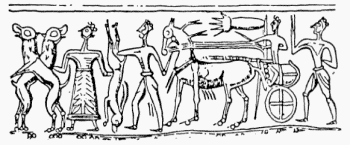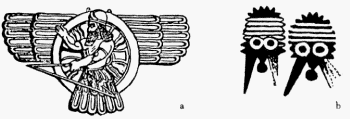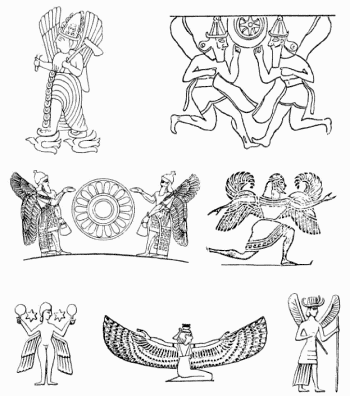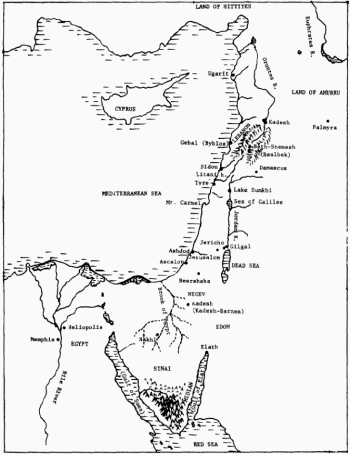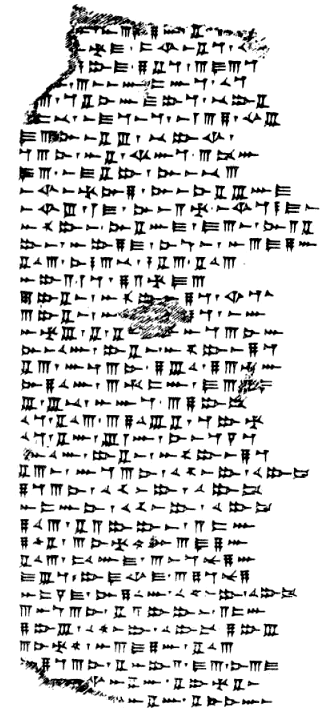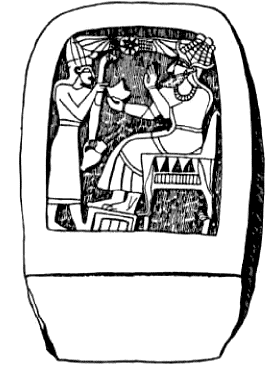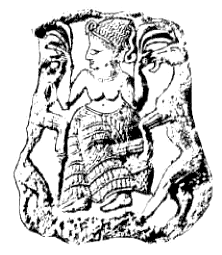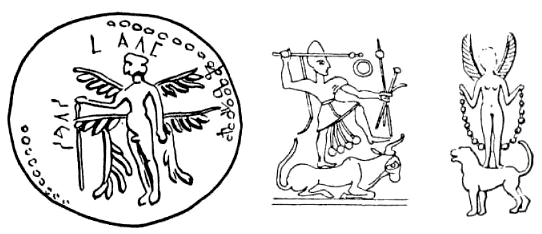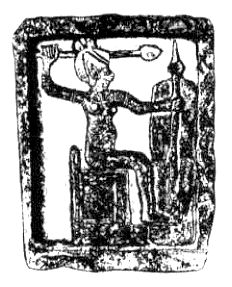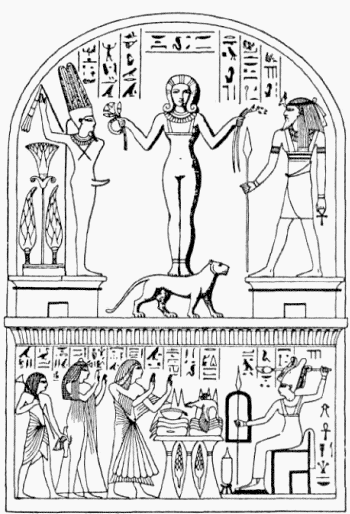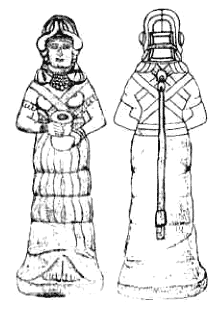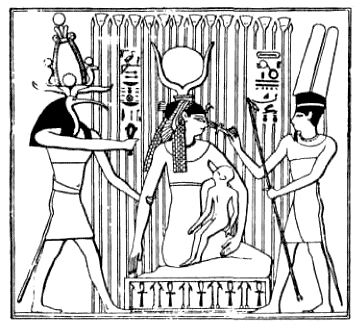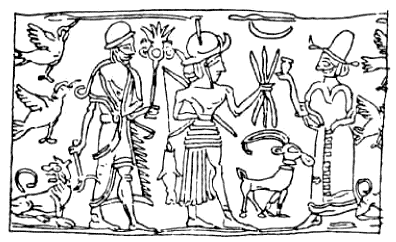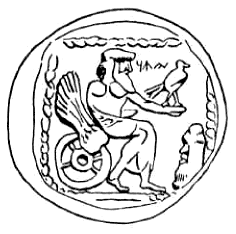|
Without question, the detailed Epic of Gilgamesh also
served as a guide book in which the subsequent searchers sought to
find the ancient landmarks by which the Land of the Living could be
reached and the way to it ascertained.
At the same time, the epic tale of the journey
can explain the confusion that reigned millenia later concerning the
exact location of the cherished target; because as our detailed
analysis has shown, Gilgamesh made not one but two journeys - a fact
generally ignored by modern scholars and possibly also by past ones.
This realization is supported by our conclusion,
that the Gods indeed had two types of craft: the GIRs, the
Rocketships that were operated from Tilmun; and what the Sumerians
called a MU, a "Sky Chamber." It is a credit to the technology of
the Nefilim that the uppermost section of the GIR, the Command
Module - what the Egyptians called Ben-Ben - could be detached and fly
in Earth's skies as a MU.
Fig. 75
The one the patriarch Jacob had seen in his vision might well have looked like the Sky Chamber of Ishtar (Fig. 66); the Flying Wheel described by the prophet Ezekiel was akin to the Assyrian depictions of their Flying God roaming the skies, at cloud level, within a spherical Sky Chamber (Fig. 76a).
Depictions found at an ancient site across the Jordan from Jericho, suggest that for landing these spherical vehicles extended three legs (Fig. 76b); they could well have been the fiery Whirlwinds in which the prophet Elijah was carried off heavenwards at that very same location.
Fig. 76
As the Sumerian "Eagles," so were the Flying Gods of antiquity depicted by all ancient peoples as Gods equipped with wings - the Winged Beings to whose depictions we can trace the Judeo-Christian acceptance of the winged Cherubim and Angels (literally: Emissaries) of the Lord (Fig. 77).
Fig. 77
Tilmun, then, was the location of the Spaceport.
The Cedar Mountain was the location of the "Landing Place," the "Crossroads of Ishtar," - the Airport of the Gods.
And it was to the latter that Gilgamesh had
first set his course.
As the biblical and other Near Eastern texts attest, the Cedars of
Lebanon were earmarked for the construction and decoration of
temples ("Gods' houses") - a practice described in detail in I Kings,
in the chapters dealing with the building of the Jerusalem Temple by
Solomon (after the Lord Yahweh had complained "Why build ye not me a
House of cedar?").
Attributing the
attempt to the king of Babylon (factually or allegorically), it is
stated that "He came to Lebanon and took the cedar's highest
branch," selecting off it a choice seed. This seed "he planted in a
fruitful field, he placed it by great waters." But what grew up was
not a tall cedar - only a willow-like tree, "a spreading vine of low
stature."
This knowledge apparently stemmed from the fact that the cedar grew in the "Orchard of the Gods." There, no other tree could match it; "it was the envy of all the trees that were in Eden, the garden of the Gods."
The Hebrew term Gan (orchard, garden), stemming as it
does from the root gnn
(protect, guard), conveys the sense of a guarded and restricted
area - the same sense as is imparted to the reader of the Gilgamesh
narrative: a forest that extends "for many leagues," watched over by
a Fiery Warrior ("a terror to mortals"), accessible only through a
gateway which paralyzed the intruder who touched it. Inside, there
was "the secret abode of the Anunnaki"; a tunnel led to "the
enclosure from which words of command are issued" - "the underground
place of Shamash."
Not so, according to the Old Testament, was the fate of another mortal king. He was the king of Tyre - a city-state on the coast of Lebanon, a short distance away from the cedar mountains; and the Deity (as told in chapter 28 of the Book of Ezekiel) did enable him to visit the Sacred Mountain:
Fig. 78
Gilgamesh sought to enter the Landing Place of the Gods uninvited; the king of Tyre not only was permitted to come to the place, but evidently was also given a ride in "the fiery stones," flying as a Cherub.
As a result, "a God I am," he said; "in the Abode of the
Deity I sat, in the midst of the waters." For his haughtiness of
heart, the prophet was to inform him, he was to die the death of a
heathen by the hands of strangers.
Such a land and such
cities-of-merchants need not have been looked-for far: along the
coast of Lebanon, from where Anatolia begins in the north to
Palestine in the south, there were several Canaanite coastal cities
whose wealth and power grew with their international commerce. Best
known from biblical narratives were Tyre and Sidon; centers of trade
and shipping for millennia, their fame reached its peak under their
Phoenician rulers.
The spectacular finds included a large palace, a temple to the God Ba'al ("The Lord"), and a variety of artifacts.
But the real treasures were scores of clay tablets inscribed in an alphabetic cuneiform script (Fig. 79), written in a "Western-Semitic" language akin to biblical Hebrew.
The tablets, whose contents were first presented by Charles Virollaud over many years in the scientific periodical Syria, retrieved from relative obscurity the Canaanites, their life and customs, and their Gods.
Fig. 79
At the head of the Canaanite pantheon was a supreme deity called El - a term which in biblical Hebrew was the generic term for "deity," stemming as it did from the Akkadian word Ilu, which literally meant "Lofty One."
But in the Canaanite tales of Gods and men, El was the personal name of an actual deity, who was the final authority in all affairs be they divine or human. He was father of the Gods, as well as Ab Adam ("father of men"); his epithets were The Kindly, The Merciful. He was "creator of things created" and the "one who alone could bestow kingship."
A stela found in Palestine (Fig. 80) depicts El seated on his throne and being served a beverage by a younger deity, probably one of his many sons.
El wears the conical, horned headdress which was the recognition mark of the Gods throughout the ancient Near East; and the scene is dominated by the omnipresent Winged Globe, emblem of the Planet of the Gods.
Fig. 80
In "olden times," El was a principal deity of Heaven and Earth. But at the time at which the events related in the tablets had taken place, El lived in semi-retirement, aloof from daily affairs.
His abode was "in the mountains," at "the two headwaters."
There he sat in his pavilion, receiving emissaries, holding councils of the Gods, and trying to resolve the recurring disputes among the younger Gods. Many of these were his own children: some texts suggest that El may have had seventy offspring.
Fig.81
Of them, thirty were by his official consort Asherah (Fig. 81); the others, by an assortment of concubines or even by human females.
One poetic text tells how two
females saw El naked as they were strolling on the beach; they were
completely charmed by the size of his penis, and ended up each
bearing him a son. (This attribute of El is prominent in a depiction
of him, as a winged God, on a Phoenician coin - Fig. 82).
Ba'al, as Zeus, was always armed with a lightning-missile (Fig. 82), the bull his cult symbol.
Fig. 82
When Zeus fought Typhon, it was his sister Athena, Goddess of War and Love, who alone stood by him; and in Egyptian tales, Isis alone stood by her brother-husband Osiris.
So it was when Ba'al fought his two brothers: his sister-lover Anat alone came to his help. Like Athena, she was on the one hand "The Maiden," often flaunting her naked beauty (Fig. 82); and on the other hand the Goddess of War, the lion a symbol of her bravery (Fig. 83). (The Old Testament called her Ashtoreth.)
Fig. 83
The links to Egyptian prehistorical recollections and beliefs were no less obvious than to those of Greece.
Osiris was resurrected by Isis after she had found his remains at the Canaanite city of Byblos. Likewise, Ba'al was brought back to life by Anat after he was smitten by Mot. Seth, the adversary of Osiris, was sometimes called in Egyptian writings "Seth of Saphon"; Ba'al, as we shall see, acquired the title "Lord of Zaphon."
Egyptian monuments of the New Kingdom - paralleling the Canaanite period - often depicted the Canaanite Gods as Egyptian deities, calling them Min, Reshef, Kadesh, Anthat (Fig. 84).
We thus find the same tales applying to the same Gods, but under different names, throughout the ancient world.
Fig. 84
Scholars have pointed out that all these tales were echoes, if not actual versions, of the much earlier and original Sumerian tales: not only of Man's Search for Immortality, but also of love, death and resurrection among the Gods.
All along, the tales are replete
with episodes, details, epithets, and teachings which also fill the
Old Testament - attesting to a common locale (greater Canaan), common
traditions and common original versions.
Much as in the Book of Genesis, we read in the Canaanite tale that Danel, getting on in years without a male heir, saw his chance to get divine help when two Gods arrived at his habitat.
The divine guests - who turn out to be El, "The Dispenser of Healing," and Ba'al - stay with Danel a whole week, during which he overwhelms them with his supplications.
To the disbelieving Danel, El promises a son.
Mount your bed, he
tells him, kiss your wife, embrace her ... "by conception and
pregnancy she will bear a male child to Danel." And just as in the
biblical tale, the matriarch does bear a Rightful Heir, and the
Succession is assured. They name him Aqhat, the Gods nickname him
Na'aman ("The Pleasant One").
To get it, she promises Aqhat anything he would like to have - silver, gold, even Immortality:
Moreover - she promised - not only would he live as long as the Gods, but he would be invited to join them for the Lifegiving ceremony:
But Aqhat does not believe that Man can escape his mortal fate, and does not wish to part with the bow:
He also points out to Anat that the bow was made for warriors like himself and not for a female to use. Insulted, Anat "traverses the land" to El's abode, to seek permission to smite Aqhat.
El's
enigmatic response permits punishment only up to a point.
There she asks Taphan to "slay Aqhat for his bow" but then "make him live again" - to put Aqhat to temporary death, only long enough for Anat to take away his bow. Taphan, following Anat's instructions, "smites Aqhat twice on the skull, thrice above the ear," and Aqhat's "soul escapes like vapor."
But before Aqhat can be revived - if Anat had ever so intended - his body is ravaged by vultures. The terrible news is brought to Danel as, "sitting before the gate, under a mighty tree, he "judges the cause of the widow, adjucates the case of the orphan."
With Baal's
aid, a search is instituted for the dismembered Aqhat, but to no
avail. In revenge, Aqhat's sister, in disguise, travels to the abode
of Taphan and, getting him drunk, attempts to slay him. (A possible
happy end, wherein Aqhat was resurrected after all. is missing.)
A depiction of her in her temple in Ashur, an Assyrian capital, showed her wearing goggles, a tight-fitting helmet and extended "ear-phones" or panels (see Fig. 58).
In the ruins of Mari on the Euphrates River, a life-sized statue of a Goddess was found, equipped with a "black box," a hose, a horned helmet with built-in earphones and other attributes of an aeronaut (Fig. 85).
This ability "as a bird to fly," also attributed to the Canaanite deities, features in all the epic tales discovered at Ugarit.
Fig. 85
One such tale, in which a Goddess flies to the rescue, is a text titled by scholars "The Legend of King Keret" - Keret being capable of interpretation as the king's personal name, or the name of his city ("The Capital").
The tale's main theme is the same as that of the
Sumerian epic of Gilgamesh: Man's striving for Immortality. But it
begins like the biblical tale of Job, and has other strong biblical
similarities.
Persuading the
Lord to test Job, Satan was permitted to afflict him first with the
loss of his children and all his wealth, and then with all manner of
sickness. As Job sat mourning and suffering, three of his friends
came to console him; the Book of Job was composed as a record of
their discussions concerning matters of life and death and the
mysteries of Heaven and Earth.
In those days, Job reminisced, he
believed that "as the Phoenix shall be my days, with my Establisher
shall I die." But now, with nothing left and afflicted with
illnesses, he felt like dying then and there.
Was he disclosing, in the hitherto uncomprehended verse, that he was of partly divine blood?
That, therefore, like Gilgamesh,
he had expected to live as long as the ever-rejuvenating Phoenix, to
die only when his "Establisher" shall die. But now he realized that
"Eternally I shall no longer live; like vapor are my days."
Daily "he enters the inner chamber" in the temple and cries to his Gods.
Finally,
El advises his "beloved lad" to stop mourning, and to remarry, for he would be blessed with a new heir. He is told to wash and make himself presentable, and go seek the hand of the daughter of the king of Udum (possibly the biblical Edom).
Keret, accompanied by
troops and laden with gifts, goes to Udum and does as El had
instructed. But the king of Udum turns down all the silver and gold.
Knowing that Keret "is the flesh of the Father of Men" - of divine
origins - he asks for a unique dowry: let the firstborn son that his
daughter shall bear Keret also be semi-divine!
The next scene takes place at the abode of El, where the appeal of Asherah is supported by the younger Gods:
Thus prodded, El consents and "blesses Keret," promising him that he shall have seven sons and several daughters.
The firstborn son, El announces, is to be named Yassib ("Permanent") for indeed he will be granted permanence. This will be achieved because when he is born, not his mother but rather the Goddesses Asherah and Anat will suckle him.
(The theme of a king's child being nursed by a Goddess, thereby being granted longer life, was depicted in the art of all the Near Eastern peoples - Fig. 86).
Fig. 86
The Gods keep their promises; but Keret, growing in wealth and power, forgets his vows; in the manner of the king of Tyre in the prophecies of Ezekiel, his heart grew haughty, and he began to boast to his children about his divine origins.
Angered, Asherah afflicted him with a fatal disease. As it became clear that Keret was on the verge of death, his sons were astonished: How can this happen to Keret, "a son of El, an offspring of the Kindly One, a holy being?"
In disbelief, the sons question their father - for surely his failed claim to Immortality has a bearing on their own lives as well:
Embarrassed, El asks the other Gods:
Seven times El issued this appeal, but "none among the Gods answers him."
In desperation,
El
appeals to the Craftsman of the Gods and his assistants, the
Crafts-Goddesses who know all magic. Responding, the "female who
removes illness," the Goddess Shataqat, takes to the air. "She flies
over a hundred towns, she flies over a multitude of villages. ..."
Arriving in the house of Keret in the nick of time, she manages to
revive him.
Ba'al's
frequent epithet is "The Rider of the Clouds" - an epithet which the
Old Testament has claimed for the Hebrew deity. Anat's own flying
capabilities, which became apparent in the tales dealing with the
relations between Gods and men, are even more highlighted in the
tales of the Gods themselves.
Fig. 87
The area happens to still be called by that very name to this day: it is Lake Sumkhi ("Lake of Fishes") in northern Israel, where the Jordan River begins to flow into the Sea of Galilee; and it is still renowned for its fishes and wildlife.
Anat decided to join Ba'al there:
Seeing her, Ba'al signaled her to come down; but Anat began to play hide-and-seek. Annoyed, Ba'al asked whether she expects him to,
The idyllic get-together, however, could take place only in later years, when the position of Ba'al as the Prince of Earth and acknowledged master of the northern lands was finally established.
Earlier, Ba'al engaged in life-and-death struggles with other
contenders for the Godly throne; the prize of all these fights was a
place known as Zarerath Zaphon - commonly translated "the Heights of
Zaphon," but specifically meaning "The Rocky Crest in the North."
This
made the first son born by her the rightful heir. But, as had
happened before, he was often challenged by the firstborn - a son who
chronologically was born first, but by another mother. (The fact
that Ba'al, who had at least three wives, could not marry
his beloved Anat confirms that she was a full, rather than a
half-sister of his.)
Learning of the ploy, Yam sends his own emissaries to the gathered Gods, to demand that the rebellious Ba'al be surrendered to him.
In the hush that followed, they present Yam's demand. To indicate that they meant business, "at El's feet they do not fall down"; they hold their weapons at the ready:
The Gods drop to the ground and take cover.
El is
willing to yield Ba'al. But Ba'al seizes his own weapons and is
about to jump the emissaries, when his mother restrains him: an
emissary bears immunity, she reminds him.
Arriving "thirsty and parched," she puts the problem before him and asks that he decide with wisdom, not emotion;
Weighing the situation, El agrees: let Ba'al be the master of the Crest of Zaphon; let him build his house
there.
Others find parallels with the Egyptian Thoth, God of
artcraft and magic. Indeed, the Ugaritic texts state that the
emissaries sent to fetch Kothar-Hasis were to look for him in Crete
and Egypt; presumably it was in those lands that his skills were
being employed at that time.
There was some disagreement between the two regarding where a funnel-like window, which could open and close in some unusual manner, should be placed.
When the structure was completed, Ba'al was concerned that his wives and children would be hurt. To
allay his fears, Kothar-Hasis ordered that trees of Lebanon, "from
Sirion its precious cedars," be piled up within the structure - and
started up a fire. For a full week the fire burnt intensely; silver
and gold within it melted down; but the structure itself was neither
damaged nor destroyed.
As Ba'al soared skyward, the divine messengers Gapan and Ugar joined him in flight:
Attaining mastery over the Fastness of Zaphon, Ba'al also acquired the title Ba'al Zaphon.
The title simply means "Lord of Zaphon," of
the Northern Place. But the original connotation of the term Zaphon
was not geographical; it meant both "the hidden-away," and "the
observation place." Undoubtedly, all these connotations played a
role in naming Ba'al "Lord of Zaphon."
While some were slaughtered, others escaped. Drunk with power, Ba'al mocked them:
His right (hand) is mighty-Pursuing his quest for mastery, Ba'al - with the aid of Anat - battled and annihilated such male adversaries as "Lothan, the serpent," Shalyat, "the seven-headed dragon," Atak "the Bullock," as well as the Goddess Hashat, "the Bitch."
We know from the Old Testament that Yahweh, the biblical Lord, was also a bitter adversary of Ba'al; and as Ba'al's influence grew among the Israelites when their king married a Canaanite princess, the prophet Elijah arranged a contest between Ba'al and Yahweh upon Mount Carmel.
When Yahweh prevailed, the three hundred priests of Ba'al were promptly executed. In this adversity, it was for Yahweh that the Old Testament claimed mastery over the Crest of Zaphon.
Significantly, the claims were made in almost identical language, as Psalm 29 and other verses make clear:
As Ba'al in the Canaanite texts, so was the Hebrew Deity "Rider of the Clouds."
The Prophet Isaiah envisioned Him flying south toward Egypt, "riding swiftly upon a cloud, he shall descend upon Egypt; the Gods of Egypt shall quail before him."
Isaiah also claimed to have personally seen the Lord and His winged attendants:
The Hebrews were forbidden to worship, and therefore to make, statues or engraved images.
But the Canaanites, who must have known of Yahweh, as the Hebrews had known of Ba'al, left us a depiction of Yahweh as conceived by them. A fourth century B.C. coin which bears the inscription Yahu ("Yahweh") depicts a bearded deity seated upon a throne shaped as a winged wheel (Fig. 88).
Fig. 88
It was thus universally assumed in the ancient Near East that lordship over Zaphon established the supremacy among the Gods who could fly about.
This, no doubt, was what Ba'al had expected. But seven years
after the Fastness of Zaphon was completed, Ba'al faced a challenge
by Mot, Lord of the southern lands and the Lower World. As it turned
out, the dispute was no longer about the mastery of Zaphon; rather,
it had to do with "who over the whole Earth dominion shall have."
Who needs war? he asked; let us
"pour peace and amity into the center of Earth." As Mot became more
persistent, Ba'al concluded that the only way to prevent Mot from
coming to Zaphon was for Ba'al to go to Mot's abode. So he journeyed
to Mot's "pit" "in the depths of Earth," professing obedience.
The two emissaries were instructed to repeat to Anat, word for word, an enigmatic message:
"Stones" in the ancient languages, we must bear in mind, encompassed all quarried or mined substances and thus included all minerals and metals.
Anat, therefore, readily understood what Ba'al was telling
her: He was setting up upon the Crest of Zaphon some sophisticated
contraption that could send or intercept secret messages!
So that was the secret: Ba'al, without the knowledge of "Heaven" - the government of the home planet - was setting up a clandestine communications center, from which he could converse with all the parts of Earth, as well as with the Spacecraft above Earth.
It was a
first step to "over the whole Earth dominion to have." In that, he
ran into direct conflict with Mot; for it was in Mot's territories
that the official "Eye of Earth" was located.
The worried emissaries were promised that she would be there on time:
Arriving at Mot's capital, she could not find Ba'al. Demanding to know his whereabouts, she threatened Mot with violence. Finally, she learnt the truth: the two Gods had engaged in hand combat, and "Ba'al was fallen." Enraged, she "with a sword cleaved Mot."
Then with the aid of Shepesh,
Quickly, the two Goddesses summoned the Craftsman of the Gods, also referred to as El Kessem - "The God of Magic."
As Thoth had revived
the snake-bitten Horus, so was Ba'al miraculously resurrected. But
whether he was resurrected physically on Earth, or in a Celestial
Afterlife (as Osiris), one cannot be certain.
It is as though Gilgamesh had penetrated the very installations which Ba'al had secretly constructed! Mystery-filled verses in the epic now assume a thrilling meaningfulness:
This, we know, took place in the third millennium B.C. - circa 2900 B.C.
The next link between the affairs of Gods and men is the tale of the
aging and heirless Danel, who had resided somewhere near Kadesh.
There is no time frame given for the tale's occurrences, but the
similarities with the biblical tale of the heirless
Abraham - including the sudden appearance of "men" who turn out to be
the Lord and his Emissaries, and the locale not far from
Kadesh - suggest the possibility that we are reading two versions of
the same ancestral memory. If so, we have another datemark: the
beginning of the second millenium B.C.
Stressing the antiquity of the place, the prophet transmitted to Sennacherib the Lord's admonition:
The same prophet likewise castigated the king of Babylon for having attempted to deify himself by scaling the Crest of Zaphon:
We have here not only confirmation of the existence of the place and
its antiquity, but also a description of it: it included a "raised
platform," from which one could ascend heavenward and become a
"Lofty One" - a God.
Fig. 89
It depicts a "great house," adjoined by a raised area, which is surrounded by a high and massive wall.
There, upon a podium
supported by cross-beams built to withstand a great weight, there is mounted a
conical object - an object familiar from so many other Near Eastern
depictions: the Celestial Chamber of the Gods - the "moving stone."
|
